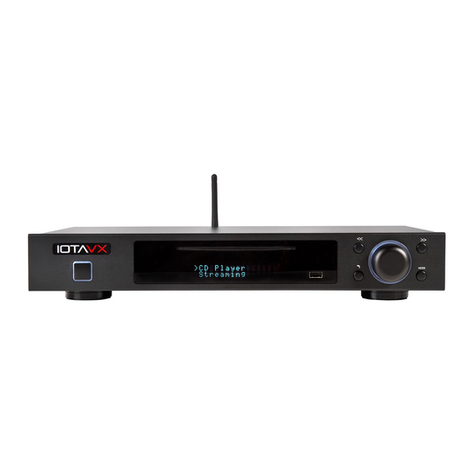
Speaker setup
Here you can configure your speaker setup. The following options are available:
● Speaker layout - Enter your speaker configuration here.
● Center speaker - Here you specify whether you are using a center speaker.
● Top speaker type - Here you specify whether you are using top speakers or ceiling speakers.
● Level test / adjust - Here you can set the volume of the individual speaker channels individually.
● Speaker distance - Here you can set the distance of the individual speakers individually.
● Subwoofer - Here you can specify how many subwoofers you are using.
● Speaker crossover - Here you can set the crossover frequency of the speaker channels
individually.
○ SW Highpass: Here you can relieve the subwoofer of low frequencies. “Not used”
should be selected by default.
○ SW LowPass: Here you can set the upper crossover frequency of the subwoofer.
● Filter slope - Here you can set the slope of the crossover frequency for each speaker and
subwoofer individually.
Room Calibration
Note: The calibration is carried out at a very high volume level in order to ensure a high quality of the
measurements.
Before you start the “Room Calibration” automatic calibration system, first make the following settings in the
speaker setup :
1. Speaker layout
2. Center speaker
3. Top speaker type
4. Subwoofer
5. Speaker crossover
6. Filter slope
Now put the device into standby mode and then connect the included microphone to the MIC input on the front of
the device. Place the microphone at ear level at your listening position facing towards the ceiling. Start the
device.
●Level / Distance
Here the device automatically determines the distance and individual volume level of all loudspeakers.
●EQ
Here the device determines an individual equalizer for room correction for each loudspeaker.
Manual EQ
Here you can select the desired equalizer preset and make settings for the equalizer presets.
● EQ 1, EQ 2, EQ 3: Three equalizer presets are available here. In these presets you can set 11 or 7
individual parametric equalizers for each speaker channel group and each subwoofer.
● Auto test EQ: The results of the automatic calibration are saved in this equalizer preset. You can adapt
the results of the measurement individually. However, the preset can also be edited freely without
automatic calibration and offers 11 or 7 individual loudspeaker channels and 5 individual parametric
equalizers for each subwoofer.
● EQBypass: Select this setting if you want to deactivate all equalizers.
You can set the equalizers (EQ's) for the equalizer presets as follows:
● Fc - Here you can select the desired frequency of the parametric EQ.
● Gain - Here you can select the level of the parametric EQ. Note: Increasing the level too much can
damage your speakers or subwoofer.
● Q - Here you can set the quality or breadth of the effect of the parametric EQ.
● Generator - Here you can output the selected frequency as a sine tone in different volumes or pink or
white noise.




























